|
|
|
Sort Order |
|
|
|
Items / Page
|
|
|
|
|
|
|
| Srl | Item |
| 1 |
ID:
156452
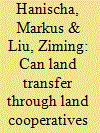

|
|
|
|
|
| Summary/Abstract |
Functioning land markets are necessary for an increase in off-farm employment. However, there is limited empirical evidence on the impact of land transfer on off-farm employment in rural China. This paper investigates the drivers of households' cooperative membership, which is equivalent to transferring land through land cooperatives, and its impact on off-farm employment. Using a two-step control function approach and data from Suzhou and Yangzhou (Jiangsu province), we do not find a general effect of cooperative membership on household heads' current off-farm employment, though the effect is large for households which had surplus agricultural labor before cooperative initiation. The effect is also positive and large for household heads without off-farm experience and households located in Yangzhou. Policy-makers should be aware of the distributional consequences of these heterogeneous effects.
|
|
|
|
|
|
|
|
|
|
|
|
|
|
|
|
| 2 |
ID:
163378


|
|
|
|
|
| Summary/Abstract |
In this article, land acquisition (LA) in India and China since the 1980s has been theorised as an ‘ideal’ model, namely, compulsory development, which highlights the extremely active role of the state and the compulsory measures it takes for LA in both countries in order to achieve its development goals. In both countries, the state acts as the land use planner, regulation maker in the land administration, as well as a major land developer and most influential player in the land market. At the same time, it extracts a high proportion of the benefits from land development projects, which is realised through compulsory LA despite the numerous flaws in the LA institutions. Compulsory development, as we term it, is a key feature in the political economy of LA in both countries. It provides an ideal model to understand and compare the phenomenon of LA in these two largest developing societies and to develop a systematic analysis of LA, and more broadly, of development in both countries. As the initial product in a larger research project, in this article we focus mainly on the theoretical model of this compulsory development, including its definition, characteristics and variations.
|
|
|
|
|
|
|
|
|
|
|
|
|
|
|
|
| 3 |
ID:
123964
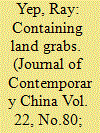

|
|
|
|
|
| Publication |
2013.
|
| Summary/Abstract |
To a certain extent, a more stringent regime for requisition of rural land may help protect the interests of peasants. There is, however, a hierarchy of income opportunity in the countryside as a result of diversification of rural economic structure in reform China. The varying degree of land dependence renders a contrasting calculation on the value of land lease among Chinese peasants. For peasants in the more prosperous regions, the conflicts are primarily triggered by their exclusion from direct engagement in the land market and deprivation of the chance to maximise potential gain that fuels the growing tension in the countryside. A more direct response to this fundamental cause, however, requires audacious moves by the Party leadership venturing into zones of political taboo.
|
|
|
|
|
|
|
|
|
|
|
|
|
|
|
|
| 4 |
ID:
120630
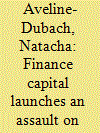

|
|
|
|
|
| Publication |
2013.
|
| Summary/Abstract |
Over the past two decades, global market finance has taken root in China to seek property investment. This article examines the spatialities and anchorage methods of finance capital within Chinese national territory. It highlights the spatial and sectoral differences in the composition of property portfolios as a function of the return/risk coupling. These differences are exacerbated by a split in the geographical origin of the funds, which determines differentiated conditions of access to land and management of the investment time horizon of the assets portfolios. The penetration of finance capital into urban space tends to increase the fragmentation and functional specialisation of districts, a phenomenon fostered by entrepreneurial urban policies. As a result, urban projects are becoming standardised in terms of both design and program. They are increasingly governed by external references that favour the expansion of multinationals and transform lifestyles and consumer habits.
|
|
|
|
|
|
|
|
|
|
|
|
|
|
|
|
| 5 |
ID:
192398
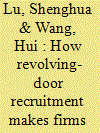

|
|
|
|
|
| Summary/Abstract |
The fact that firms seek political connections through revolving-door recruitment is widely acknowledged around the world. Using an original database including the information of listed firms' board members and parcel-level land transaction records, this paper documents how revolving-door recruitment makes firms stand out in China's land market. We show that firms with revolving-door recruitment receive special deals in land transactions, which are simultaneously reflected in the quantity and price of land. Specifically, connected firms buy more parcels and larger areas of land in the primary land market. Due to the particularity of industrial land, price discounts are only identified for commercial and residential land, while not for industrial land. Measuring economic activity by night light intensity, we find no evidence that land transaction under the influence of political connections has a negative impact on economic activity on land. Our research advances the understanding that the state-business relationship is an essential factor in resource allocation in an emerging market with government intervention.
|
|
|
|
|
|
|
|
|
|
|
|
|
|
|
|
| 6 |
ID:
110496
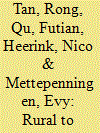

|
|
|
|
|
| Publication |
2011.
|
| Summary/Abstract |
The current system of converting farmland to urban land use in China can be characterized as a hybrid system that combines government controls with market-based transfers. In this paper we argue that this hybrid governance structure causes an over-conversion of farmland from the rural to the urban sector, as compared to a competitive market situation, and a welfare reallocation that discriminates against farmland owners. We develop a partial equilibrium model that can be used to examine the impact of the current hybrid governance structure on the over-conversion of farmland and to analyze the welfare changes for different groups of actors and the resulting net social welfare loss. Using a dataset with detailed information on farmland acquisitions and urban land transactions in Yingtan City in Jiangxi Province, we illustrate how this framework can be applied. Our results indicate an over-conversion of 33.5% of the total converted farmland in this city between 1999 and 2003. The welfare of farmland owners affected by the conversion decreased by 1.38 billion RMB, while the net social welfare loss equaled more than 270 million RMB during the same period. The local government obtained 380 million RMB of revenues by re-selling farmland as urban land through competitive conveyance mechanisms between 2002 and 2005, while the manufacturing sector gained an estimated 280 million RMB from buying land use rights at relatively low prices. We conclude that the current policy of increasing urban land conveyance through competitive mechanisms does not address two major underlying causes of over-conversion, and that protection of farmland would be better served by replacing the current hybrid rural to urban land market structure by a competitive land market.
|
|
|
|
|
|
|
|
|
|
|
|
|
|
|
|
|
|
|
|
|